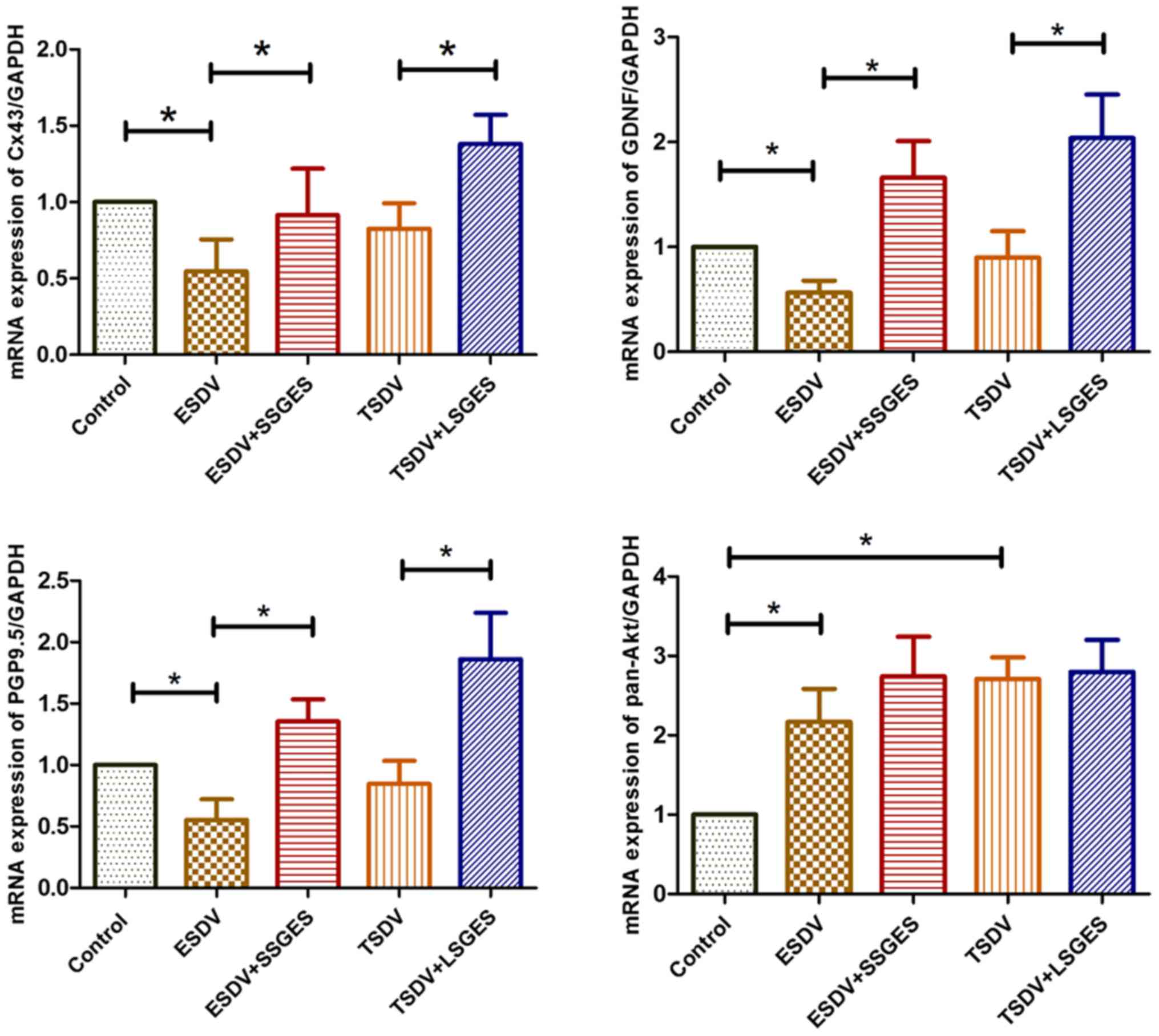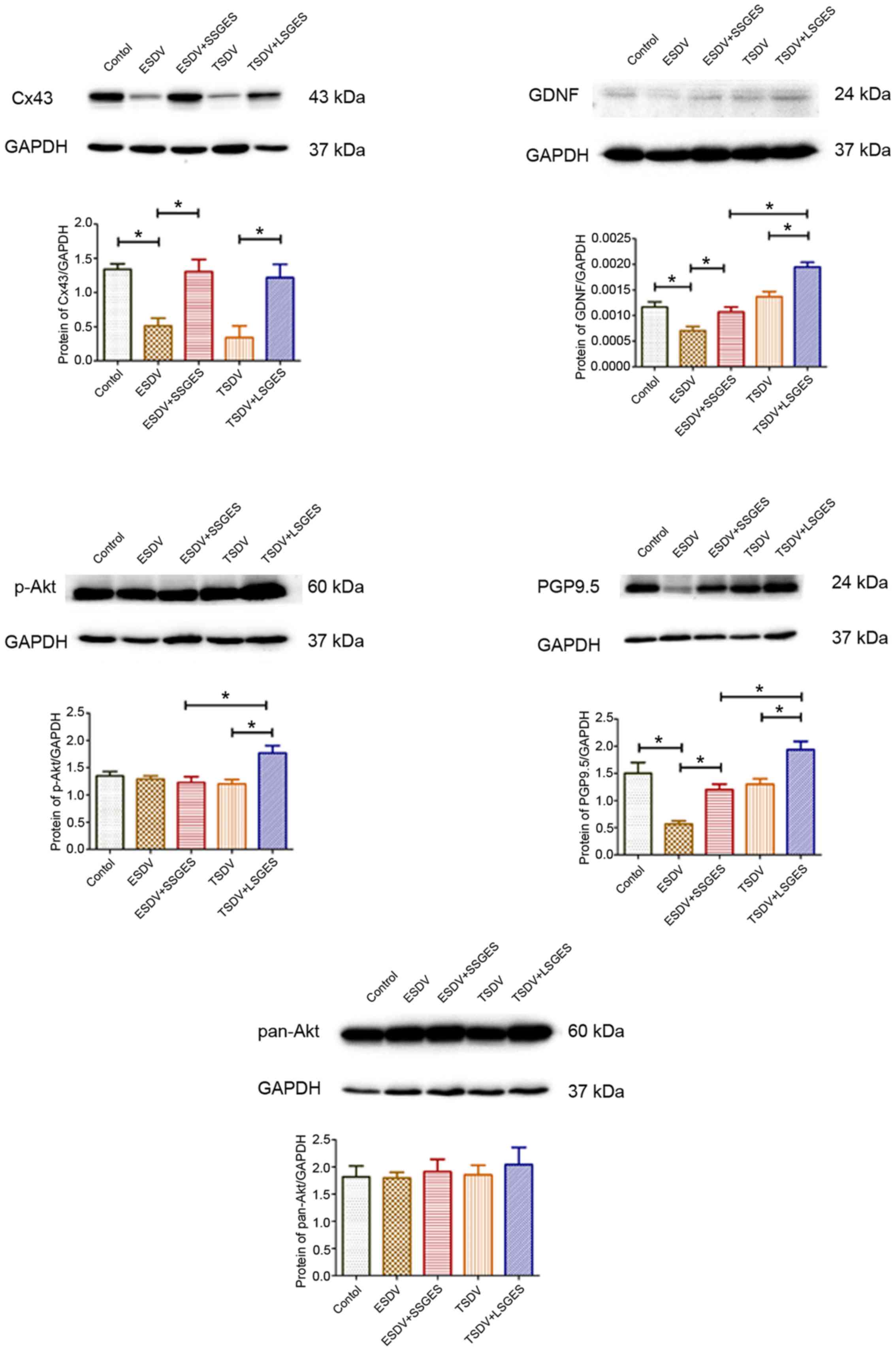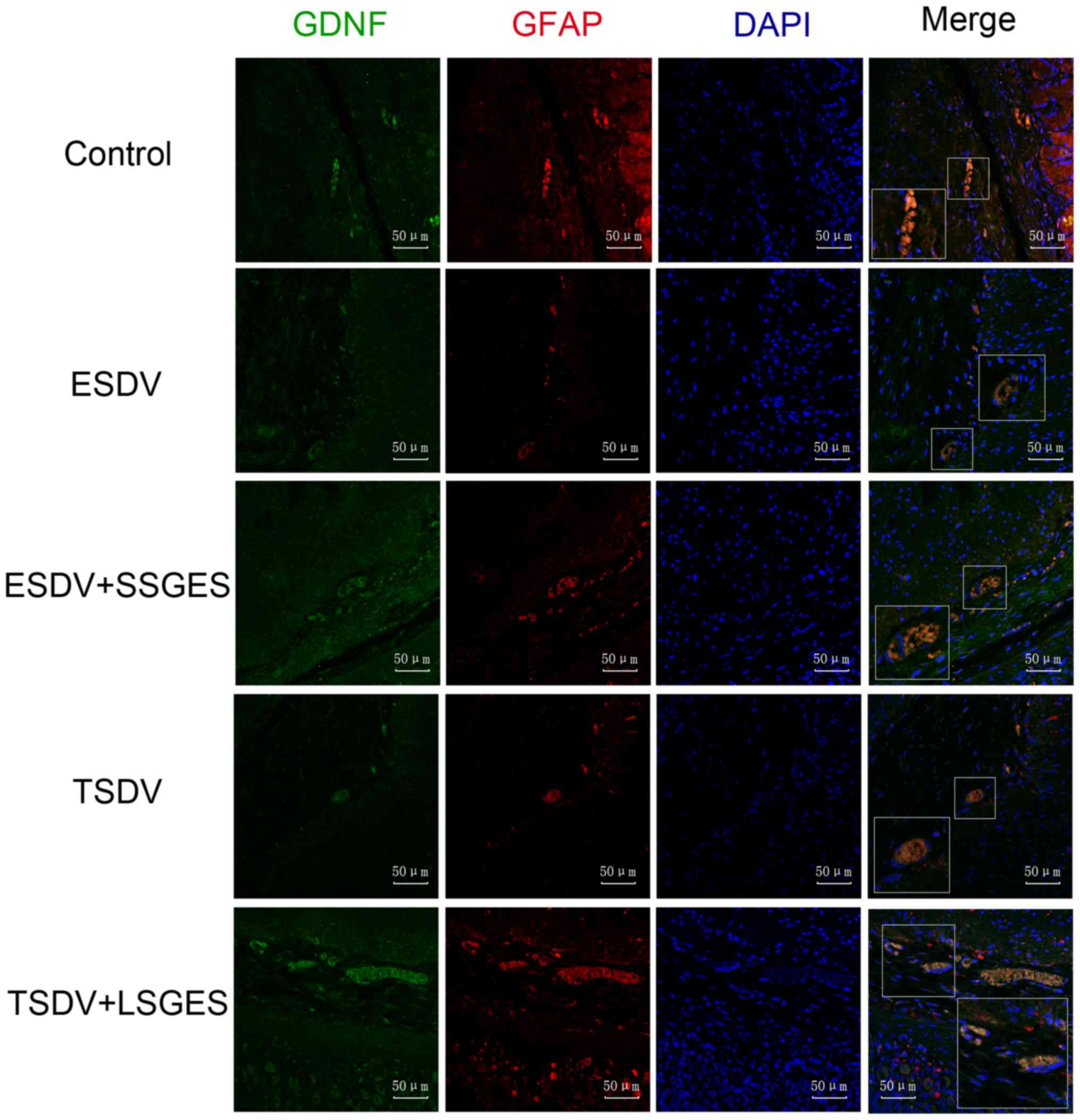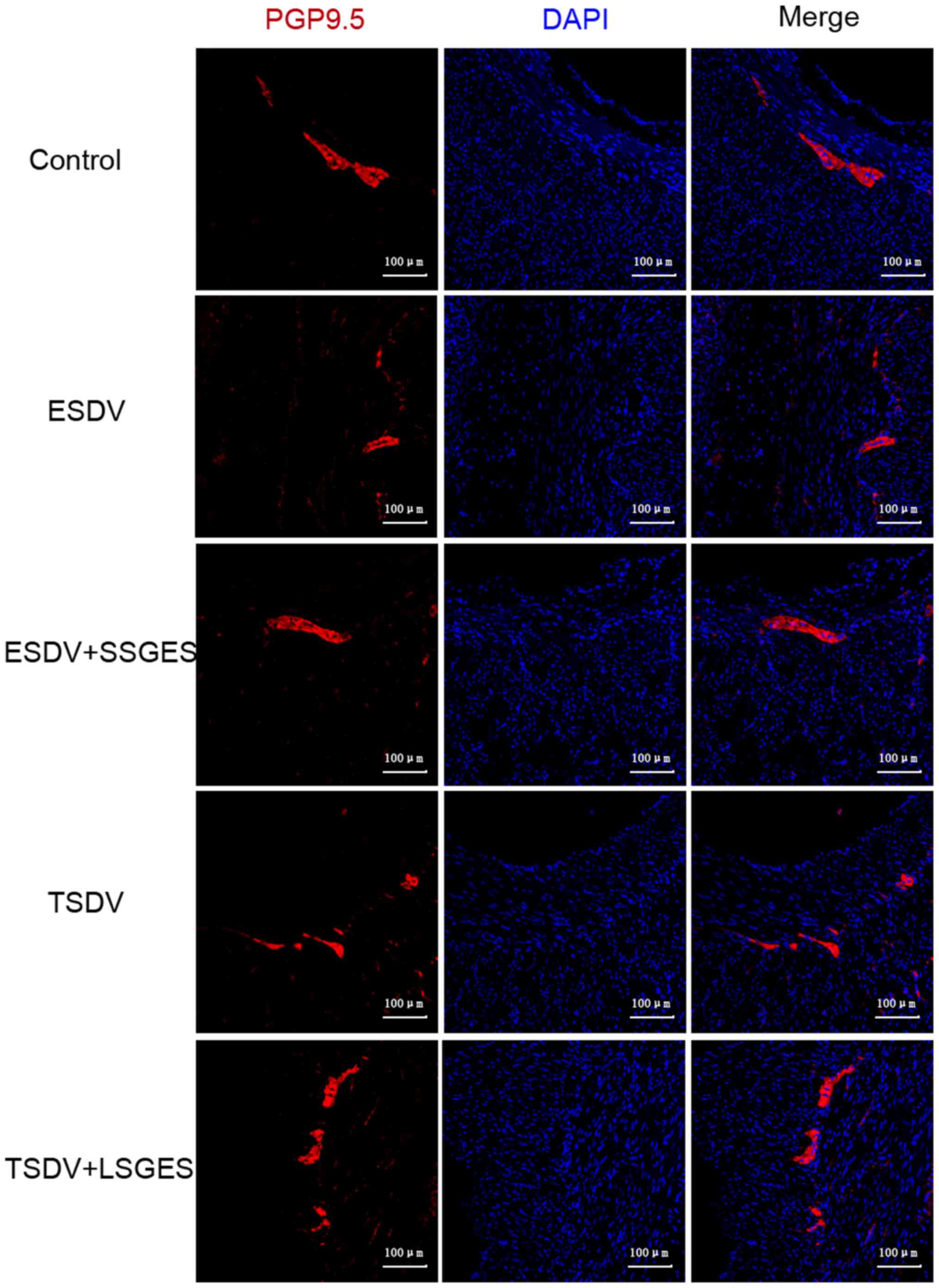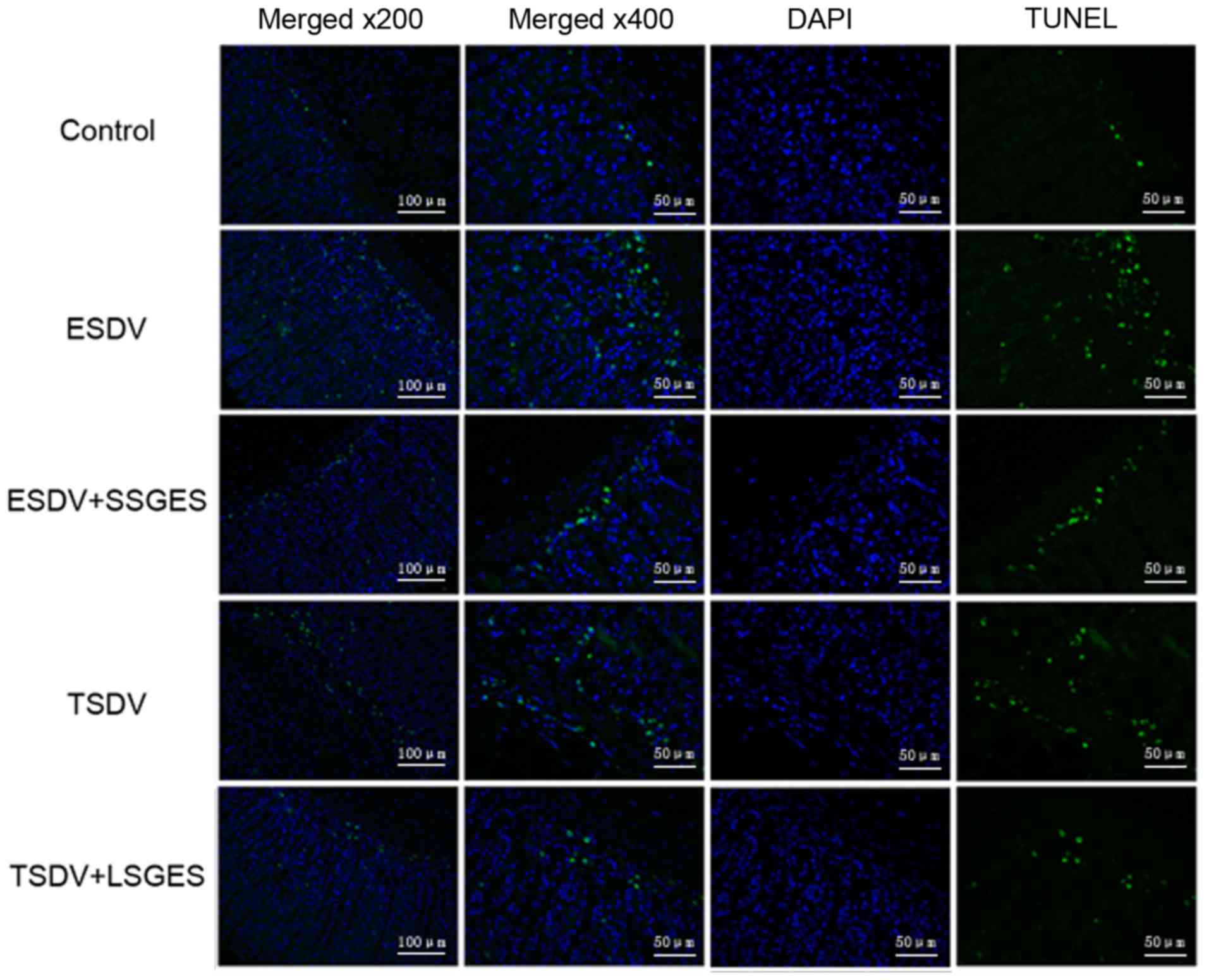|
1
|
Lakkireddy D, Reddy YM, Atkins D,
Rajasingh J, Kanmanthareddy A, Olyaee M, Dusing R, Pimentel R,
Bommana S and Dawn B: Effect of atrial fibrillation ablation on
gastric motility: the atrial fibrillation gut study. Circ
Arrhythmia Electrophysiol. 8:531–536. 2015. View Article : Google Scholar
|
|
2
|
Costantini TW, Bansal V, Krzyzaniak M,
Putnam JG, Peterson CY, Loomis WH, Wolf P, Baird A, Eliceiri BP and
Coimbra R: Vagal nerve stimulation protects against burn-induced
intestinal injury through activation of enteric glia cells. Am J
Physiol Gastrointest Liver Physiol. 299:G1308–G1318. 2010.
View Article : Google Scholar : PubMed/NCBI
|
|
3
|
Holmes GM: Upper gastrointestinal
dysmotility after spinal cord injury: Is diminished vagal sensory
processing one culprit? Front Physiol. 3:2772012. View Article : Google Scholar : PubMed/NCBI
|
|
4
|
Tajdaran K, Gordon T, Wood MD, Shoichet MS
and Borschel GH: A glial cell line-derived neurotrophic factor
delivery system enhances nerve regeneration across acellular nerve
allografts. Acta Biomater. 29:62–70. 2016. View Article : Google Scholar
|
|
5
|
Taba Taba Vakili S, Kailar R, Rahman K,
Nezami BG, Mwangi SM, Anania FA and Srinivasan S: Glial cell
line-derived neurotrophic factor-induced mice liver defatting: A
novel strategy to enable transplantation of steatotic livers. Liver
Transpl. 22:459–467. 2016. View
Article : Google Scholar
|
|
6
|
Du F, Wang L, Qian W and Liu S: Loss of
enteric neurons accompanied by decreased expression of GDNF and
PI3K/Akt pathway in diabetic rats. Neurogastroenterol Motil.
21:1229-e1142009. View Article : Google Scholar : PubMed/NCBI
|
|
7
|
Anitha M, Gondha C, Sutliff R, Parsadanian
A, Mwangi S, Sitaraman SV and Srinivasan S: GDNF rescues
hyperglycemia-induced diabetic enteric neuropathy through
activation of the PI3K/Akt pathway. J Clin Invest. 116:344–356.
2006. View
Article : Google Scholar : PubMed/NCBI
|
|
8
|
Du F and Liu S: Electroacupuncture with
high frequency at acupoint ST-36 induces regeneration of lost
enteric neurons in diabetic rats via GDNF and PI3K/AKT signal
pathway. Am J Physiol Regul Integr Comp Physiol. 309:R109–R118.
2015. View Article : Google Scholar : PubMed/NCBI
|
|
9
|
Sun Y, Tan Y, Song G and Chen JD: Effects
and mechanisms of gastric electrical stimulation on visceral pain
in a rodent model of gastric hyperalgesia secondary to chemically
induced mucosal ulceration. Neurogastroenterol Motil. 26:176–186.
2014. View Article : Google Scholar
|
|
10
|
Yu X, Tu L, Lei P, Song J, Xu H and Hou X:
Antiemesis effect and brain fMRI response of gastric electrical
stimulation with different parameters in dogs. Neurogastroenterol
Motil. 26:1049–1056. 2014. View Article : Google Scholar : PubMed/NCBI
|
|
11
|
Heckert J, Sankineni A, Hughes WB,
Harbison S and Parkman H: Gastric electric stimulation for
refractory gastroparesis: A prospective analysis of 151 patients at
a single center. Dig Dis Sci. 61:168–175. 2016. View Article : Google Scholar
|
|
12
|
Song GQ, Zhu H, Lei Y, Yuan C, Starkebaum
W, Yin J and Chen JD: Gastric electrical stimulation optimized to
inhibit gastric motility reduces food intake in dogs. Obes Surg.
25:1047–1055. 2015. View Article : Google Scholar
|
|
13
|
Kuhlman J and Eisen JS: Genetic screen for
mutations affecting development and function of the enteric nervous
system. Dev Dyn. 236:118–127. 2007. View Article : Google Scholar
|
|
14
|
Bagyánszki M, Krecsmarik M, De Winter BY,
De Man JG, Fekete E, Pelckmans PA, Adriaensen D, Kroese AB, Van
Nassauw L and Timmermans JP: Chronic alcohol consumption affects
gastrointestinal motility and reduces the proportion of neuronal
NOS-immunoreactive myenteric neurons in the murine jejunum. Anat
Rec (Hoboken). 293:1536–1542. 2010. View
Article : Google Scholar
|
|
15
|
Ishihara E, Nagahama M, Naruse S, Semba R,
Miura T, Usami M and Narita M: Neuropathological alteration of
aquaporin 1 immunoreactive enteric neurons in the
streptozotocin-induced diabetic rats. Auton Neurosci. 138:31–40.
2008. View Article : Google Scholar
|
|
16
|
Liu W, Yue W and Wu R: Overexpression of
Bcl-2 promotes survival and differentiation of neuroepithelial stem
cells after transplantation into rat aganglionic colon. Stem Cell
Res Ther. 4:72013. View
Article : Google Scholar : PubMed/NCBI
|
|
17
|
Bar KJ, Facer PA, Williams NS, Tam PK and
Anand PR: Glial-derived neurotrophic factor in human adult and
fetal intestine and in Hirschsprung's disease. Gastroenterology.
4:1381–1385. 1997. View Article : Google Scholar
|
|
18
|
Heuckeroth RO, Lampe PA Jr, Johnson EM Jr
and Milbrandt J: Neurturin and GDNF promote proliferation and
survival of enteric neuron and glial progenitors in vitro. Dev
Biol. 200:116–129. 1998. View Article : Google Scholar : PubMed/NCBI
|
|
19
|
Sánchez MP, Silos-Santiago I, Frisén J, He
B, Lira SA and Barbacid M: Renal agenesis and the absence of
enteric neurons in mice lacking GDNF. Nature. 5686:70–73. 1996.
View Article : Google Scholar
|
|
20
|
Meir M, Flemming S, Burkard N, Bergauer L,
Metzger M, Germer CT and Schlegel N: Glial cell line-derived
neurotrophic factor promotes barrier maturation and wound healing
in intestinal epithelial cells in vitro. Am J Physiol Gastrointest
Liver Physiol. 309:G613–G624. 2015. View Article : Google Scholar : PubMed/NCBI
|
|
21
|
Barrenschee M, Böttner M, Hellwig I, Harde
J, Egberts JH, Becker T and Wedel T: Site-specific gene expression
and localization of growth factor ligand receptors RET, GFRα1 and
GFRα2 in human adult colon. Cell Tissue Res. 354:371–380. 2013.
View Article : Google Scholar : PubMed/NCBI
|
|
22
|
Böttner M, Harde J, Barrenschee M, Hellwig
I, Vogel I, Ebsen M and Wedel T: GDNF induces synaptic vesicle
markers in enteric neurons. Neurosci Res. 77:128–136. 2013.
View Article : Google Scholar : PubMed/NCBI
|
|
23
|
Zhang Y, Lan R, Wang J, Li XY, Zhu DN, Ma
YZ, Wu JT and Liu ZH: Acupuncture reduced apoptosis and upregulated
BDNF and GDNF expression in hippocampus following hypoxia-ischemia
in neonatal rats. J Ethnopharmacol. 172:124–132. 2015. View Article : Google Scholar : PubMed/NCBI
|
|
24
|
Zhu G, Wang X, Wu S, Li X and Li Q:
Neuroprotective effects of puerarin on
1-methyl-4-phenyl-1,2,3,6-tetrahydropyridine induced Parkinson's
disease model in mice. Phytother Res. 28:179–186. 2014. View Article : Google Scholar
|
|
25
|
Huang SM, Chen TS, Chiu CM, Chang LK, Liao
KF, Tan HM, Yeh WL, Chang GR, Wang MY and Lu DY: GDNF increases
cell motility in human colon cancer through VEGF-VEGFR1
interaction. Endocr Relat Cancer. 21:73–84. 2013. View Article : Google Scholar : PubMed/NCBI
|
|
26
|
Abdo H, Derkinderen P, Gomes P, Chevalier
J, Aubert P, Masson D, Galmiche JP, Vanden Berghe P, Neunlist M and
Lardeux B: Enteric glial cells protect neurons from oxidative
stress in part via reduced glutathione. FASEB J. 24:1082–1094.
2010. View Article : Google Scholar
|
|
27
|
Abdo H, Mahé MM, Derkinderen P,
Bach-Ngohou K, Neunlist M and Lardeux B: Bach-NgohouK, NeunlistM
and LardeuxB: The omega-6 fatty acid derivative
15-deoxy-Δ12,14-prostaglandin J2 is involved in neuroprotection by
enteric glial cells against oxidative stress. J Physiol.
590:2739–2750. 2012. View Article : Google Scholar : PubMed/NCBI
|
|
28
|
Nasser Y, Fernandez E, Keenan CM, Ho W,
Oland LD, Tibbles LA, Schemann M, MacNaughton WK, Rühl A and
Sharkey KA: Role of enteric glia in intestinal physiology: Effects
of the gliotoxinfluorocitrate on motor and secretory function. Am J
Physiol Gastrointest Liver Physiol. 291:G912–G927. 2006. View Article : Google Scholar : PubMed/NCBI
|
|
29
|
Aubé AC, Cabarrocas J, Bauer J, Philippe
D, Aubert P, Doulay F, Liblau R, Galmiche JP and Neunlist M:
Changes in enteric neurone phenotype and intestinal functions in a
transgenic mouse model of enteric glia disruption. Gut. 55:630–637.
2006. View Article : Google Scholar
|
|
30
|
Xu L, Sun X, Lu J, Tang M and Chen JD:
Effects of gastric electric stimulation on gastric distention
responsive neurons and expressions of CCK in rodent hippocampus.
Obesity. 16:951–957. 2008. View Article : Google Scholar : PubMed/NCBI
|
|
31
|
Yang W, Wang N, Shi X and Chen J:
Synchronized dual pulse gastric electrical stimulation induces
activation of enteric glial cells in rats with diabetic
gastroparesis. Gastroenterol Res Pract. 2014:9640712014. View Article : Google Scholar : PubMed/NCBI
|
|
32
|
Wang N, Song S and Chen J: Syncronized
dual pulse gastric electrical stimulation improves gastric emptying
and activates enteric glial cells via upregulation of GFAP and
S100B with different courses of subdiaphragmatic vagotomy in rats.
Mol Med Rep. 15:3826–3832. 2017.PubMed/NCBI
|
|
33
|
Chen J, Pasricha PJ, Yin J, Lin L and Chen
JD: Hepatic electrical stimulation reduces blood glucose in both
type-I and type-II diabetic rats. Neurogastroenterol Motil.
22:1109-e2862010. View Article : Google Scholar
|
|
34
|
Chen J, Koothan T and Chen JD:
Synchronized gastric electrical stimulation improves
vagotomy-induced impairment in gastric accommodation via the
nitrergic pathway in dogs. Am J Physiol Gastrointest Liver Physiol.
296:G310–G318. 2009. View Article : Google Scholar :
|
|
35
|
McClain JL, Grubišić V, Fried D,
Gomez-Suarez RA, Leinninger GM, Sévigny J, Parpura V and Gulbransen
BD: Ca2+ responses in enteric glia are mediated by
connexin-43 hemichannels and modulate colonic transit in mice.
Gastroenterology. 2:497–507. 2014. View Article : Google Scholar
|
|
36
|
Brand-Schieber E, Werner P, Iacobas DA,
Iacobas S, Beelitz M, Lowery SL, Spray DC and Scemes E: Connexin43,
the major gap junction protein of astrocytes, is down-regulated in
inflamed white matter in an animal model of multiple sclerosis. J
Neurosci Res. 80:798–808. 2005. View Article : Google Scholar : PubMed/NCBI
|
|
37
|
Abell T, McCallum R, Hocking M, Koch K,
Abrahamsson H, Leblanc I, Lindberg G, Konturek J, Nowak T, Quigley
EM, et al: Gastric electrical stimulation for medically refractory
gastroparesis. Gastroenterology. 125:421–428. 2003. View Article : Google Scholar : PubMed/NCBI
|
|
38
|
Brody F, Vaziri K, Saddler A, Ali A,
Drenon E, Hanna B, Akin E, Gonzalez F and Soffer E: Gastric
electrical stimulation for gastroparesis. J Am Coll Surg.
207:533–538. 2008. View Article : Google Scholar : PubMed/NCBI
|
|
39
|
Chu H, Lin Z, Zhong L, McCallum RW and Hou
X: Treatment of high-frequency gastric electrical stimulation for
gastroparesis. J Gastroenterol Hepatol. 27:1017–1026. 2012.
View Article : Google Scholar
|
|
40
|
Horbach T, Thalheimer A, Seyfried F,
Eschenbacher F, Schuhmann P and Meyer G: abiliti®
closed-loop gastric electrical stimulation system for treatment of
obesity: clinical results with a 27-month follow-up. Obes Surg.
25:1779–1787. 2015. View Article : Google Scholar : PubMed/NCBI
|
|
41
|
Zhang J, Tang M and Chen JD: Gastric
electrical stimulation for obesity: The need for a new device using
wider pulses. Obesity (Silver Spring). 17:474–480. 2009. View Article : Google Scholar
|
|
42
|
Goetze O, Nikodem AB, Wiezcorek J, Banasch
M, Przuntek H, Mueller T, Schmidt WE and Woitalla D: Predictors of
gastric emptying in Parkinson's disease. Neurogastroenterol Motil.
18:369–375. 2006. View Article : Google Scholar : PubMed/NCBI
|
|
43
|
Marrinan S, Emmanuel AV and Burn DJ:
Delayed gastric emptying in Parkinson's disease. Mov Disord.
29:23–32. 2014. View Article : Google Scholar
|
|
44
|
Dickerson RN, Mitchell JN, Morgan LM,
Maish GO III, Croce MA, Minard G and Brown RO: Disparate response
to metoclopramide therapy for gastric feeding intolerance in trauma
patients with and without traumatic brain injury. JPEN J Parenter
Enteral Nutr. 33:646–655. 2009. View Article : Google Scholar : PubMed/NCBI
|
|
45
|
Qualls-Creekmore E, Tong M and Holmes GM:
Time-course of recovery of gastric emptying and motility in rats
with experimental spinal cord injury. Neurogastroenterol Motil.
22:62–69. e27–e28. 2010.
|















